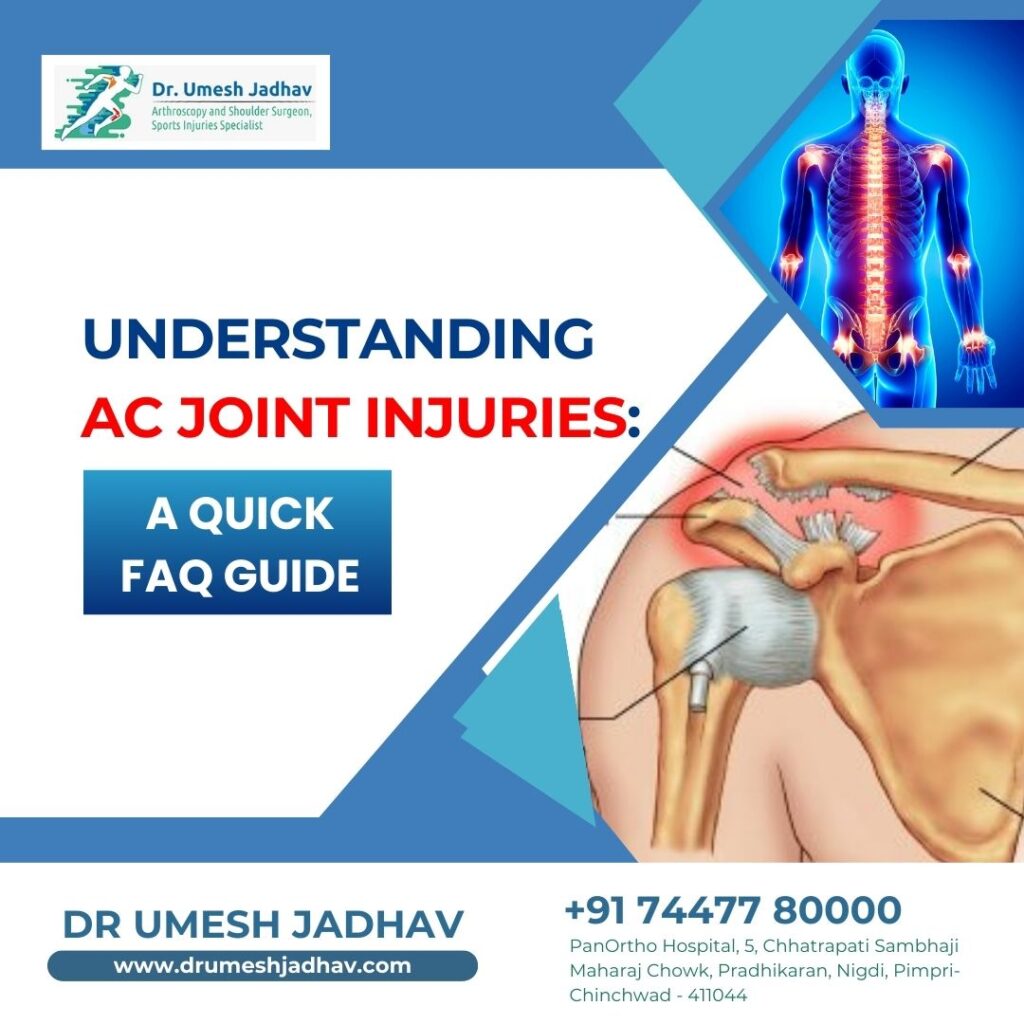The acromioclavicular (AC) joint is an important part of the shoulder, connecting the collarbone (clavicle) to the shoulder blade (scapula). Injuries to this joint can cause pain, discomfort, and limited mobility. AC joint injuries are common among athletes, often occurring due to falls on an outstretched arm or direct impact. In this article, Dr. Umesh Jadhav, a leading Orthopedics and Sports Medicine Specialist in PCMC, discusses AC joint injuries and answers some of the most frequently asked patient questions. If you’re experiencing any of the symptoms mentioned, schedule an appointment today for expert care.
What is the AC Joint, and What Are the Symptoms of an AC Joint Injury?
Your shoulder is made up of three bones: the clavicle (collarbone), scapula (shoulder blade), and humerus (upper arm bone). The acromioclavicular (AC) joint is where the scapula’s acromion meets the clavicle. This joint plays a crucial role in shoulder movement and stability. It is held together by three key ligaments: the acromioclavicular, coracoclavicular, and coracoacromial ligaments.
An AC joint injury can occur due to trauma, such as a fall or direct impact, leading to pain, swelling, and restricted movement in the shoulder. Recognizing these symptoms early can help in seeking the right treatment.
Signs and Symptoms of an AC Joint Injury
If you have an AC joint injury, you may experience the following symptoms:
- Pain at the top of the shoulder
- Discomfort when lying on the affected side
- Increased pain with heavy lifting, overhead, or across-body movements
- Swelling and bruising around the shoulder
- Tenderness over the AC joint
- Reduced range of motion and stability
- Decreased shoulder strength
- A visible bump on the top of the shoulder
- A popping sound or catching sensation during movement
Recognizing these symptoms early can help in seeking the right treatment and preventing further complications.
What Are the Most Common Causes of AC Joint Pain?
AC joint pain can result from chronic overuse or direct trauma. The most common causes include:
Repetitive Overhead Motions (Chronic Irritation)
Activities that involve frequent overhead movements can strain the AC joint over time, leading to pain and inflammation. These include:
- Baseball
- Weightlifting
- Volleyball
- Basketball
High-Risk Contact Sports and Falls
Sports with a higher risk of falls, collisions, or direct impact to the shoulder can cause AC joint injuries. Common examples include:
- Football
- Wrestling
- Rugby
- Biking
- Snow sports
- Hockey
Both repetitive strain and sudden impact can contribute to AC joint pain, making it essential to take preventive measures and seek proper treatment from Sports Medicine Specialist when needed.
Types of AC Joint Injuries
AC joint injuries are classified into six types based on severity:
- Type I: A mild injury where the force applied is not strong enough to tear the acromioclavicular or coracoclavicular ligaments. This results in a sprain that causes pain but no visible joint dislocation.
- Type II: A more significant injury where the AC ligaments are torn, but the coracoclavicular ligaments remain intact (though sprained). This often leads to a noticeable prominence of the lateral clavicle.
- Type III: A severe injury where both the AC and coracoclavicular ligaments are completely torn, causing the clavicle to separate from the scapula. This results in a visible bump at the AC joint.
- Type IV: In this rare injury, the clavicle is pushed backward (posterior displacement) and may become lodged within the trapezius muscle.
- Type V: A more extreme version of Type III, where the clavicle is significantly displaced due to muscle attachments being disrupted.
- Type VI (Rare): A rare and severe injury where the distal clavicle is displaced downward, either below the acromion or the coracoid process.
The severity of an AC joint injury determines the treatment approach, ranging from rest and rehabilitation for minor cases to surgery for more severe dislocations.
Can Physical Therapy Help?
Once an AC joint injury is diagnosed, your physician will create a personalized recovery plan. While most patients start feeling better within a few days to a week, full healing of the AC ligaments typically takes at least six weeks. During this time, it’s essential to reduce strain on the joint to prevent overstretching the healing tissue. Using a sling, tape, or shoulder brace can help, but physical therapy is the key to a successful recovery.
Physical Therapy Goals for AC Joint Injury Recovery
- Restoring Range of Motion – Helping you move your shoulder comfortably and without pain.
- Strength Training – Rebuilding shoulder strength to prevent future injuries.
- Pain Management – Reducing discomfort so you can return to daily activities.
- Functional Training – Teaching proper movement patterns to avoid putting excess strain on the AC joint.
A structured physical therapy program plays a crucial role in regaining shoulder function and ensuring long-term joint stability.
Who Should I Talk to About My Recovery Options?
Dr. Umesh Jadhav, an orthopedic specialist in Nigdi, PCMC, is highly experienced in advanced arthroscopic techniques and complex shoulder reconstructive procedures, including tendon transfers, shoulder replacement, and reverse shoulder replacement. If you suspect an AC joint injury, schedule an appointment with Dr. Jadhav today. His expertise and dedication to sports medicine will help you recover and return to your favorite activities stronger than ever.

